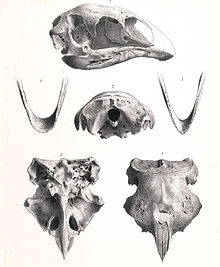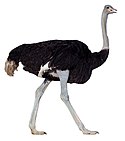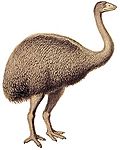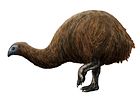Broad-billed moa
| Broad-billed moa Temporal range: Pleistocene-Holocene
| |
|---|---|

| |
| Skull | |
| Scientific classification | |
| Domain: | Eukaryota |
| Kingdom: | Animalia |
| Phylum: | Chordata |
| Class: | Aves |
| Infraclass: | Palaeognathae |
| Order: | †Dinornithiformes |
| Family: | †Emeidae |
| Genus: | †Euryapteryx Haast, 1874 |
| Species: | †E. curtus
|
| Binomial name | |
| †Euryapteryx curtus | |
| Synonyms | |
|
List
| |
The broad-billed moa, stout-legged moa[5][6] or coastal moa (Euryapteryx curtus) is an extinct species of moa that was endemic to New Zealand.
Taxonomy
[edit]A 2009 genetic study showed that Euryapteryx curtus and Euryapteryx gravis were synonyms.[7] A 2010 study explained size differences among them as sexual dimorphism.[8] A 2012 morphological study interpreted them as subspecies instead.[9] E. c. curtus, the nominate subspecies, was labeled the "coastal moa",[1] while E. c. gravis was the "stout-legged moa".[2]
The cladogram below follows a 2009 analysis by Bunce et al.:[10]
| Dinornithiformes |
| ||||||||||||||||||||||||||||||
Description
[edit]It was a ratite and a member of the lesser moa family. The ratites are flightless birds with a sternum without a keel. They also have a distinctive palate. The origin of these birds is becoming clearer as it is now believed that early ancestors of these birds were able to fly and flew to the southern areas that they have been found in.[11]
Habitat and distribution
[edit]
It was one of the most widespreas moa species, inhabiting open areas.[6] These moa lived in both the North and the South Islands of New Zealand, and on Stewart Island. Its habitat was in the lowlands (duneland, forest, shrubland, and grassland).[11]
Behaviour and ecology
[edit]As of 2006, half of all complete or mostly complete moa eggs in museum collections are likely broad-billed moa specimens.[12] Of the specimens traditionally given the name Euryapteryx gravis, the eggs has an average length of 205mm and width of 143mm, while the group traditionally assigned to the name Euryapteryx curtus had an average length of 122mm and width of 94mm.[12] The species presumably went extinct for the same reasons as other moa - overhunting by the Māori (who called them "moa hakahaka")[2] upon their arrival in the 14th century.
References
[edit]- ^ a b "Euryapteryx curtus curtus. NZTCS". nztcs.org.nz. Retrieved 29 April 2023.
- ^ a b c "Euryapteryx curtus gravis. NZTCS". nztcs.org.nz. Retrieved 29 April 2023.
- ^ Owen, R. (1846). A History of British Fossil Mammals and Birds. London, UK: John Van Voorst.
- ^ Checklist Committee Ornithological Society of New Zealand (2010). "Checklist-of-Birds of New Zealand, Norfolk and Macquarie Islands and the Ross Dependency Antarctica" (PDF). Te Papa Press. Retrieved 4 January 2016.
- ^ "Stout-legged moa | New Zealand Birds Online".
- ^ a b Tennyson, Alan J. D. (2006). Extinct birds of New Zealand. Paul Martinson. Wellington, N.Z.: Te Papa Press. p. 36. ISBN 978-0-909010-21-8. OCLC 80016906.
- ^ Bunce, Michael; Worthy, Trevor H.; Phillips, Matthew J.; Holdaway, Richard N.; Willerslev, Eske; Haile, James; Shapiro, Beth; Scofield, R. Paul; Drummond, Alexei; Kamp, Peter J. J.; Cooper, Alan (8 December 2009). "The evolutionary history of the extinct ratite moa and New Zealand Neogene paleogeography" (PDF). Proceedings of the National Academy of Sciences. 106 (49): 20646–20651. Bibcode:2009PNAS..10620646B. doi:10.1073/pnas.0906660106. PMC 2791642. PMID 19923428.
- ^ Gill, B. J. (2010). "Regional comparisons of the thickness of moa eggshell fragments (Aves: Dinornithiformes)". Records of the Australian Museum. 62: 115–122. doi:10.3853/j.0067-1975.62.2010.1535.
- ^ Worthy, T. H.; Scofield, R. P. (2012). "Twenty-first century advances in knowledge of the biology of moa (Aves: Dinornithiformes): a new morphological analysis and moa diagnoses revised". New Zealand Journal of Zoology. 39 (2): 87–153. doi:10.1080/03014223.2012.665060. S2CID 83768608.
- ^ Bunce et al. 2009.
- ^ a b Davies, S. J. J. F. (2003). "Moas". In Hutchins, Michael (ed.). Grzimek's Animal Life Encyclopedia. Vol. 8: Birds I: Tinamous and Ratites to Hoatzins (2nd ed.). Farmington Hills, MI: Gale Group. ISBN 0-7876-5784-0.
- ^ a b Gill, B. J. (2006). "A Catalogue of Moa Eggs (Aves: Dinornithiformes)". Papahou: Records of the Auckland Museum. 43: 55–80. ISSN 1174-9202. JSTOR 42905885. Wikidata Q58623352.




